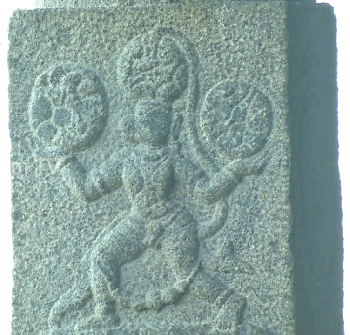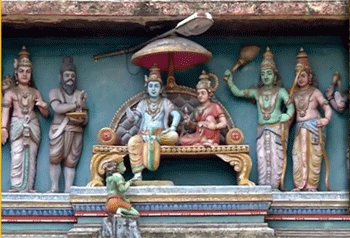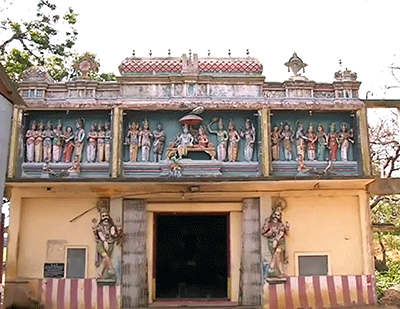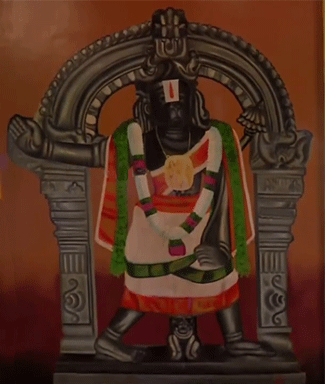
Introduction
There is a kshetra ‘Sri Tirumalai Vaiyapuri’ near Chennai. The presiding deity of this kshetra is Sri Prasanna Venkatesa Perumal. The temple is atop a hillock. The legend goes that Sri Garuda Bhagawan wished to the Lord of Tirumalai Sri Venkatesa Perumal that he would serve him as an umbrella. Lord granted him his wishes which would be fulfilled at the sacred hillock near Palar, where He will be present as a presiding deity. The said kshetra is now known as ‘Sri Tirumalai Vaiyapuri’ near Chennai which is also known as ‘Dhakshina Tirumalai’ and the hillock is known as ‘Dhakshina Garudathri’. Since it is the abode of Lord Venkatesa it is Tirumalai, but why the suffix Vaiyapuri?
Tirumalai Vaiyapuri
 To know the reason for the suffix Vaiyapuri, let us go back to the Ramayana period. In the fierce battle that happened between Ravana’s son Inderjit and Lakshmana, Inderjit hits Lakshmana with a deadly arrow. Hit by this arrow, Lakshmana falls and loses his consciousness. Seeing his brothers’ condition Rama wailed in despair. Jambhavan calls Vibhishana and Hanuman at this desperate hour for consultation. Vibishan calls the Lankan Royal physician Sushena who advises them to fetch four divine herbs - Mrutha Sanjeevani (For life), Vishalyakarani (For cuts and injury), Sandhanakarani (For skin) and Savarnyakarani (For skin color) from Dronagiri. He had advised that the medicine should be administrated before sunrise. It was realized that only Sri Hanuman could achieve this task of bringing the plants in this short time.
To know the reason for the suffix Vaiyapuri, let us go back to the Ramayana period. In the fierce battle that happened between Ravana’s son Inderjit and Lakshmana, Inderjit hits Lakshmana with a deadly arrow. Hit by this arrow, Lakshmana falls and loses his consciousness. Seeing his brothers’ condition Rama wailed in despair. Jambhavan calls Vibhishana and Hanuman at this desperate hour for consultation. Vibishan calls the Lankan Royal physician Sushena who advises them to fetch four divine herbs - Mrutha Sanjeevani (For life), Vishalyakarani (For cuts and injury), Sandhanakarani (For skin) and Savarnyakarani (For skin color) from Dronagiri. He had advised that the medicine should be administrated before sunrise. It was realized that only Sri Hanuman could achieve this task of bringing the plants in this short time.
Sri Hanuman was flying and carrying the Sanjeevani Mountain from Dronagiri to Lanka. On the way when flying over Dhakshina Tirumalai, He offered His prayers to Sri Venkatesa Perumal. Since the Sanjeevani Mountain cannot be kept on the ground, Sri Hanuman while offering His prayers to the Lord, changed the mountain from one hand to another without putting it on the ground to offer prayers to the Lord.
This act of Sri Hanuman had given the kshetra the suffix ‘Vaiyapuri’. In Tamil Vai means keeping, vaiya means not keeping, and puri means place. Since Sri Hanuman had offered His prayers to Lord Venkatesa even while on an important mission and not kept the mountain on the ground this kshetra had come to be known as ‘Tirumalai Vaiyapuri’.
This kshetra is also known by the name of ‘Tirumalai Vaiyavoor’.
Sri Venkatesa Perumal Temple
 The temple for Lord Sri Venkatesa Perumal is atop the hillock in this kshetra. There are two separate shrines with flag posts each for Lord Varaha [with Sri Lakshmi on His lap] and Lord Venkatesa Perumal. As in Tirupati, prayers are offered to Lord Sri Venkatesa Perumal, only after the prayers are offered to Lord Varaha moorthi. There are separate shrines for Alarmel Thyar, Sri Rama – Lakshmana – Sri Sita Devi, Sri Venugopal –Rukmani - Satyabhama, Sri Ramnujar etc. In one of the pillars of mandapam, a Shilpa depicts the act of Sri Hanuman changing the Sanjeevini Mountain from one hand to the other thereby the kshetra getting the name ‘Vaiyapuri’.
The temple for Lord Sri Venkatesa Perumal is atop the hillock in this kshetra. There are two separate shrines with flag posts each for Lord Varaha [with Sri Lakshmi on His lap] and Lord Venkatesa Perumal. As in Tirupati, prayers are offered to Lord Sri Venkatesa Perumal, only after the prayers are offered to Lord Varaha moorthi. There are separate shrines for Alarmel Thyar, Sri Rama – Lakshmana – Sri Sita Devi, Sri Venugopal –Rukmani - Satyabhama, Sri Ramnujar etc. In one of the pillars of mandapam, a Shilpa depicts the act of Sri Hanuman changing the Sanjeevini Mountain from one hand to the other thereby the kshetra getting the name ‘Vaiyapuri’.
This kshetra is located in the area covered earlier by Tondaimandalam. Tondaimandalam covers the present-day areas of Nellore, Chittoor, Vellore, Ranipet, Tirupattur, Tiruvanamalai, Villupuram, Kallakuruchi, Tiruvallur, Kanchipuram, Chengalpattu, Cuddalore. The rulers of Tondaimandalam were known by the title Tondaiman. One of the early rulers of Tondaimandalam had built this temple for Sri Venkatesa Perumal on this hillock.
Sri Veera Hanuman Temple
 One has to climb about five hundred steps to reach the top of the hillock. The temple of Sri Hanuman is located just in front of the stairs leading to the Lord Venkatesa Perumal. Adjacent to Sri Hanuman temple there is a temple for Sri Sidhi Budhi Vinayagar. The car used for the temple car festival is also seen in the compound of the Hanuman temple. The temple faces north and the hillock. A huge hall and the garbhagraham form the temple. Devotees can have a darshan of the Lord from the main road itself.
One has to climb about five hundred steps to reach the top of the hillock. The temple of Sri Hanuman is located just in front of the stairs leading to the Lord Venkatesa Perumal. Adjacent to Sri Hanuman temple there is a temple for Sri Sidhi Budhi Vinayagar. The car used for the temple car festival is also seen in the compound of the Hanuman temple. The temple faces north and the hillock. A huge hall and the garbhagraham form the temple. Devotees can have a darshan of the Lord from the main road itself.
On the side walls of the hall, large paintings depicting the Sthala Puranam can be seen. In front of the garbhagraham on the roof, navagrahas with their vahanam can be seen. The devotee who seeks the blessing of any navagraha can stand just below that and offer his prayers to Sri Hanuman. The devotee will not be able to take his eyes away from the imposing and magnificent sight of Sri Hanuman.
Raja Todar Mal was the Finance Minister (Mushriff-i-Diwan) of the Mughal Empire during Emperor Akbar's reign. He was also one of the Navaratnas in Akbar's court. Under Todar Mal, there were 15 other Dewans nominated for 15 Subahs of Akbar. It is said this temple for Sri Hanuman was built by him in 1558.
The act of Sri Hanuman had given the kshetra the suffix ‘Vaiyapuri’. In Tamil Vai means keeping, vaiya means not keeping, and puri means place. Since Sri Hanuman had offered His prayers to Lord Venkatesa even while on an important mission and not kept the mountain on the ground this kshetra had come to be known as ‘Tirumalai Vaiyapuri’.
It is also to state that according to the book ‘Sri Veera Anjaneyan’ by Sri u.ve. Ramakrishnan Iyengar Swamy published by LIFCO, this ancient Sri Veera Anjaneya was reinstalled at the newly constructed temple at the present place by Sri Sitarama Swamigal who is a Govinda uppasakar.
Sri Veera Hanuman
 The idol of Sri Hanuman is fully sculpted with tiruvacchi [prabhai] from single hard granite. The Lord is seen facing north and is in a standing position.
The idol of Sri Hanuman is fully sculpted with tiruvacchi [prabhai] from single hard granite. The Lord is seen facing north and is in a standing position.
The lotus feet of the Lord are adorned with thandai and nupuram. Lord is wearing dothi in kacham style and a girdle made of a triple string of muJja-grass. His left hand adorning a keyuram in the upper arm and bracelet on his forearm is seen resting on the left hip, and in His right hand, he is holding the stem of a sowgandika flower. The flower which is still to bloom is seen above His left shoulder. The bahu-vallayam adds beauty to His shoulders. The yagjopaviitam is seen across His broad chest. He is wearing two malas as ornaments, one of which has a pendant adorning His bosom. With His raised right hand showing ‘abhaya mudra’, He showers blessings on His devotees. The tail of the Lord coiled on the back is not seen – as a pious devotee offering prayers to the Lord. The Lord is wearing ear-studs which are touching His shoulders. The Lord is also wearing ‘karna pushpam’ in His ears. Neatly combed ‘sheka’ tied in a knot could be seen on the top of the head held neatly by a decorative headband. A portion of His curly kesam is seen flowing on the side of the ears adding beauty to the ‘Sundram’.
The uniqueness of the Lord of this kshetra is that He is facing the devotees directly with both eyes. His bright eyes are emanating compassion on the devotee. With such bright radiant eyes, the Lord of the kshetra bestows all the righteous things to His devotee.
Location of the temple: "Sri Hanuman Temple, Tirumalai Vaiyapuri, Tamil Nadu"
Experience
Hanuman, who had prayed to the Lord of this kshetra with all piety and had discharged all the duties assigned to him without any hindrance, is sure to guide us as to how to achieve righteous things without any obstruction.
SRI HANUMAN THINKS DIFFERENTLY, THINKS FAST
THINKS AHEAD AND ACTS FOR SURE
Ed [June 2022]
revised: 12.03.23
Updates: [10.08.22 / Jan 2025]
All pictures are TV grab from "Puthuyugam"TV
